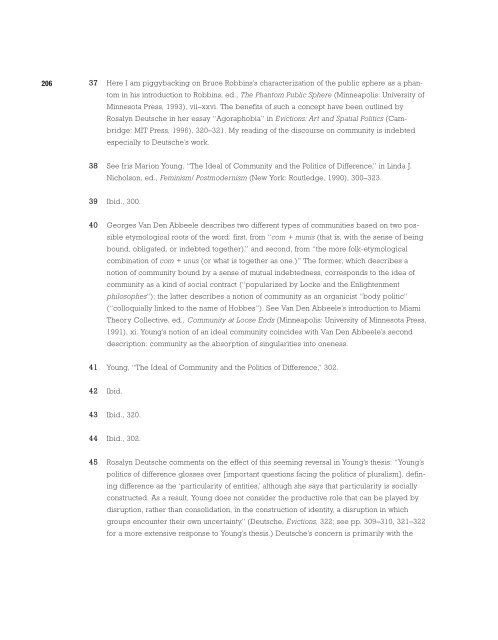ONE PLACE AFTER ANOTHER - Monoskop
ONE PLACE AFTER ANOTHER - Monoskop
ONE PLACE AFTER ANOTHER - Monoskop
You also want an ePaper? Increase the reach of your titles
YUMPU automatically turns print PDFs into web optimized ePapers that Google loves.
206<br />
37 Here I am piggybacking on Bruce Robbins’s characterization of the public sphere as a phan-<br />
tom in his introduction to Robbins, ed., The Phantom Public Sphere (Minneapolis: University of<br />
Minnesota Press, 1993), vii–xxvi. The benefits of such a concept have been outlined by<br />
Rosalyn Deutsche in her essay “Agoraphobia” in Evictions: Art and Spatial Politics (Cam-<br />
bridge: MIT Press, 1996), 320–321. My reading of the discourse on community is indebted<br />
especially to Deutsche’s work.<br />
38 See Iris Marion Young, “The Ideal of Community and the Politics of Difference,” in Linda J.<br />
Nicholson, ed., Feminism/ Postmodernism (New York: Routledge, 1990), 300–323.<br />
39 Ibid., 300.<br />
40 Georges Van Den Abbeele describes two different types of communities based on two possible<br />
etymological roots of the word: first, from “com + munis (that is, with the sense of being<br />
bound, obligated, or indebted together),” and second, from “the more folk-etymological<br />
combination of com + unus (or what is together as one.)” The former, which describes a<br />
notion of community bound by a sense of mutual indebtedness, corresponds to the idea of<br />
community as a kind of social contract (“popularized by Locke and the Enlightenment<br />
philosophes”); the latter describes a notion of community as an organicist “body politic”<br />
(“colloquially linked to the name of Hobbes”). See Van Den Abbeele’s introduction to Miami<br />
Theory Collective, ed., Community at Loose Ends (Minneapolis: University of Minnesota Press,<br />
1991), xi. Young’s notion of an ideal community coincides with Van Den Abbeele’s second<br />
description: community as the absorption of singularities into oneness.<br />
41 Young, “The Ideal of Community and the Politics of Difference,” 302.<br />
42 Ibid.<br />
43 Ibid., 320.<br />
44 Ibid., 302.<br />
45 Rosalyn Deutsche comments on the effect of this seeming reversal in Young’s thesis: “Young’s<br />
politics of difference glosses over [important questions facing the politics of pluralism], defining<br />
difference as the ‘particularity of entities,’ although she says that particularity is socially<br />
constructed. As a result, Young does not consider the productive role that can be played by<br />
disruption, rather than consolidation, in the construction of identity, a disruption in which<br />
groups encounter their own uncertainty.” (Deutsche, Evictions, 322; see pp. 309–310, 321–322<br />
for a more extensive response to Young’s thesis.) Deutsche’s concern is primarily with the

















